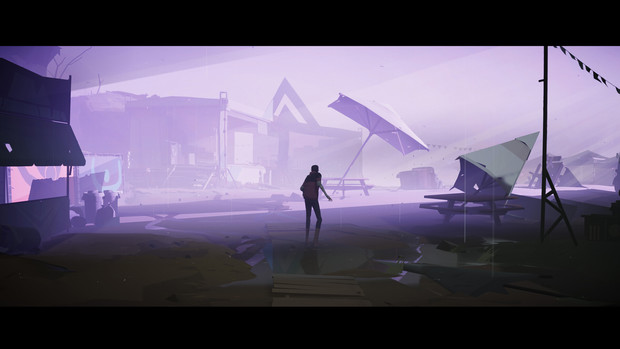Somerville review

- 0 Comments
Stunning 3D alien invasion puzzle-platformer could have used a bit more seasoning
I grew up around extraterrestrials. Probably not real ones (unless my childhood suspicions about my sisters are ever confirmed), but thanks to my dad’s fascination with the subject of alien life, I have fond memories of UFO movies, documentaries about Roswell, and lying in my bed listening to the X-Files theme tune emanating from the blocky TV set that sat in our wood-paneled den. So when it comes to a game about a visitation from outer space, I feel oddly at home.
Somerville is Jumpship’s debut title, but studio co-founder Dino Patti is no alien to the industry, having previously co-founded Playdead, where he was the executive producer of both Limbo and Inside. If you’ve played either of those puzzle adventures, the gameplay and storytelling here will feel immediately familiar: You’ll guide your silent protagonist through atmospheric locales as you solve environmental puzzles, try (and fail) to piece together vague story clues, and get promptly annihilated by things you didn’t see coming. Forward progress is sometimes hampered by obtuse design decisions, and the scant narrative threads begin unraveling towards the end in a way that emotionally undermines what came before, but it’s a cinematic experience the whole way through, with careful attention to visual detail and some great set pieces, if not quite as memorable as its more acclaimed predecessors.
Despite the otherworldly premise, the game starts in a way that’s more grounded than either Limbo or Inside. A car pulls up to an old house nestled in the foothills somewhere in rural America. A couple and their toddler son climb out and head towards the house, shopping bag in hand and a happy dog yipping at their heels. After some credits slides, we cut to the snuggling family asleep on the couch in front of the TV. The child wakes up and the first bit of gameplay has you controlling the tyke as things start to go awry: humming sounds, TV goes static, bright lights out the window, that sort of thing. The kid is tottering around, oblivious. This opening sequence, which eventually switches control over to the dad, is haunting and tense, channeling films like Close Encounters of the Third Kind or Signs. Cinematically, it’s pitch-perfect. But already, cracks are starting to show in how the gameplay is delivered.

Inside, while the environments were 3D, was limited to a 2D plane in terms of character movement. With Somerville, you’re given the full 3D plane to explore. Control-wise, it works intuitively enough with both controller and keyboard (though I’d say controller is preferable), but what you can and can’t interact with isn’t especially clear. There are subtle hints, like certain areas being more brightly lit than others, but there are no hotspot indicators or to-do lists here. In a way, this aids the sense of immersion, not being distracted by UI or overly “gamey” elements. But it also has this obnoxious tendency to break the flow of the game. In that first sequence, I got a little confused as to what my two-year-old character was supposed to be up to, so I was waddling aimlessly around the furniture until it became clear that the aliens were going to patiently wait on me to find the next trigger so they could get on with their invasion.
But the trigger was found, and invasion happened. Once the main father character makes contact with … an alien soldier? Or something? ... he blacks out and wakes up a while later in a full War of the Worlds situation. The house is destroyed, his family is gone, and the picturesque countryside is dotted with the shells of vacated space vessels. On the bright side, he’s gained a nifty new power that lets him interact with some of the alien tech. It’s here where the bulk of the gameplay resides: You set out across the town in search of … well, something, I’m sure. Because the game is wordless, the exact motivation for your actions is often unclear. I mean, I’d assume he wants to do something about all this mess, and presumably find his family, but where exactly you’re going is never spelled out. As a player, your goal is to go wherever the path isn’t blocked. In this way, it’s quite similar to the Playdead games.
The visuals and sound design are a real high point throughout Somerville. It’s clear that the designers had film in mind as they constructed each scene, carefully placing and panning the virtual camera to create stunning compositions out of the low-poly, smooth-textured 3D models. The bright, saturated alien energy effects pop above the otherwise muted color palette, and the subtle diffused lighting and film grain effects add a cinematic haze suited to the moody, abandoned locations you visit. Add to all of that some densely layered soundscapes and a sparse, droning soundtrack that hums and swells underneath, and you have yourself a pretty compelling audio-visual package.

But this isn’t just a walking tour through pretty set pieces. As you travel along, you’ll be met with obstacles that will either try to stump you, or barring that, just go ahead and kill you. The puzzles aren’t taxing, once you figure out what exactly the goal is, and they usually center around using your special ability. As you explore, you’ll frequently run into some kind of crystallized blue space matter blocking passages, impeding your progress. Your arm pulses with blue energy, and when you grab a light source, like a street light or a desk lamp, the light turns blue, and directing the beam onto the substance makes it … retract? Melt? Graphically, it’s a pretty neat effect, looking almost like basalt columns suddenly sinking into the ground and bobbing just above the surface. Later you’ll get a second power that does essentially the opposite, freezing liquified material into a solid, allowing you to walk on it.
Many of the challenges revolve around utilizing these abilities to give you a path forward, alongside other more standard environmental puzzle activities like pushing and pulling objects. Because of the aforementioned difficulty with pinpointing what can be interacted with, there were a few places where I was stuck for some time, not because of any particular mental challenge, but because I didn’t find the correct location to push the “A” button. In one scene, I wandered around a gnarled mess of abandoned cars on a highway, unable to find a way forward. It seemed especially aggravating because, had this been the ol’ “real life,” the obvious solution would be to scramble over a sedan or two. The game’s solution, which wouldn’t have been in my personal top 10 list if I were actually facing the situation, felt contrived and was found only after trying to interact with everything in the area.
Other than a few moments of artificiality, the scenarios are generally engaging, and there’s an ever-present sense of impending danger. And of course, in a game modeled after the Playdead catalog, that danger sometimes tangibly shows up ready to end you, often before you’ve even become aware of its presence. There are a few relatively static hazards that need to be spotted and avoided to keep from being, say, crushed or electrocuted, and then there are the active threats coming in the form of tractor beams scanning through the woods or robotic visitors stalking you from the shadows. Although there’s no platforming involved, you’ll still need quick reflexes to escape these close encounters, but they’re always limited to the immediate area, and when you inevitably mess up a time or two, you’re never set back very far from your point of demise.
It would be too much of a spoiler to describe how the plot progresses, but there’s a set of short scenes in the latter half of the game that I thought were exceptionally well-paced, exciting, tense, cinematic, and a good bit of fun. It felt like the climax of a good suspense film, and I was enjoying myself enough that had it ended somewhere around there, it may have been a tad predictable but I would have left it feeling largely satisfied. Except that kind of simple wrapping wasn’t Playdead’s style, and Jumpship has picked up the torch of narrative obscurity and run with it. In doing so, unfortunately, they seem to have tossed a good portion of the emotional investment out with the bathwater.
There are actually five different endings to Somerville, which I didn’t even realize until long after I’d finished playing. I had actually found two, but I thought one was more of a slightly elaborate way of losing than an “ending” per se. The other ending I got is the most common, and also highly unsatisfying, with a narrative approach that felt vaguely reminiscent of 2001: A Space Odyssey’s bizarre and divisive finale. Just when you’re finally feeling invested in the story and the fate of the characters, the emotional weight of the narrative seems all but abandoned, and the pacing slows considerably while you experience scene after disjointed scene that add more questions than answers, until you finally arrive at something you can only assume is a kind of metaphor, if only you knew what it was all about. Credits roll.
Top internet searches on Playdead games include “Limbo game meaning” and “Inside game explained,” so perhaps it’s no surprise that you’ll find similar online discussion and speculations with Somerville’s endings. It may be that you enjoy this kind of thing more than I do, but it makes matters worse that the “good ending,” which I only ever watched online, is buried underneath a meta-puzzle so obscure that I have yet to find anywhere that it’s actually explained, beyond letting you know that you would have had to take copious notes of things you didn’t imagine were important and then decipher all that even further. While this outcome is ultimately more satisfying, it seems unlikely that anyone but the most dedicated (and possibly lucky?) would find it.
Final Verdict
Over the years, the stories about extraterrestrials that have stuck with me are actually about humanity, drawing us into understanding ourselves and our place in the universe. Somerville, unfortunately, doesn’t quite soar to those stellar heights during its four-hour runtime, as the player is never really invited into the world and its characters. But while the story, and especially the baffling third act, may not be something to phone home about, the style and level of artistic craftsmanship make it an immersive experience all the same. Even with a smattering of awkward gameplay and puzzle moments, you may find that the cinematic scenes, harrowing encounters, and exciting late-game build-up ultimately make it worth the visitation.
Hot take
An artfully made take on the familiar story of an alien invasion, Somerville’s visual design and interesting scenarios form an engaging experience, though some confusing puzzle design and a plot that holds the player at arm’s length keep it from truly being out of this world.
Pros
- Art style and sound design set a great atmosphere
- Engaging, tense, cinematic set pieces
- The otherworldly powers you gain are fun to use
- Most puzzles are interesting without being overly difficult
Cons
- Wordless story is too vaguely told and loses its grounding at the very end
- 3D navigation presents some confusion
- The most favorable ending is hidden by an extremely obscure meta-puzzle
Brian played Somerville on PC using a review code provided by the game's publisher.










0 Comments
Want to join the discussion? Leave a comment as guest, sign in or register in our forums.
Leave a comment